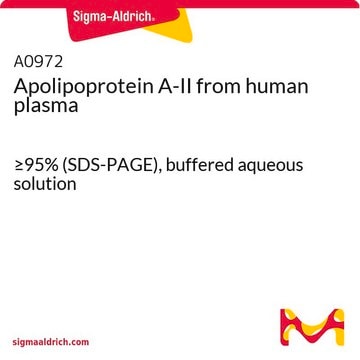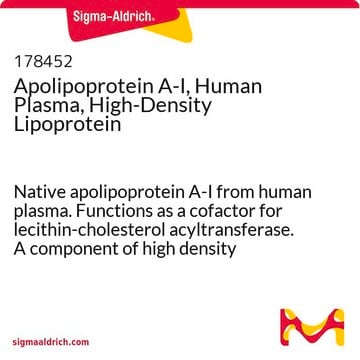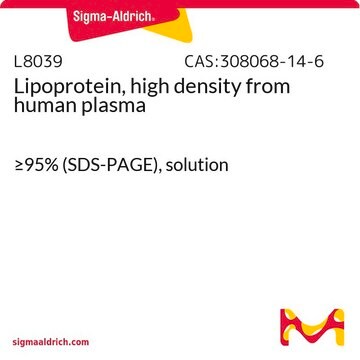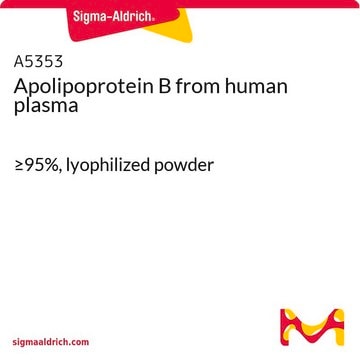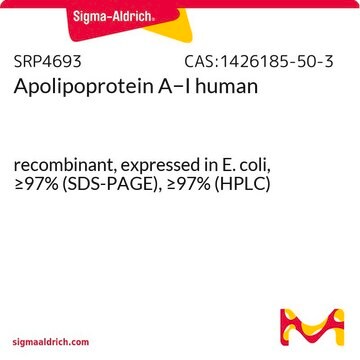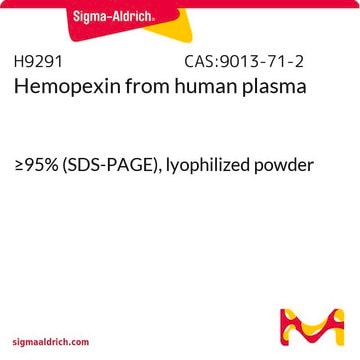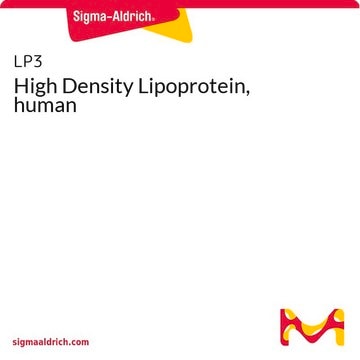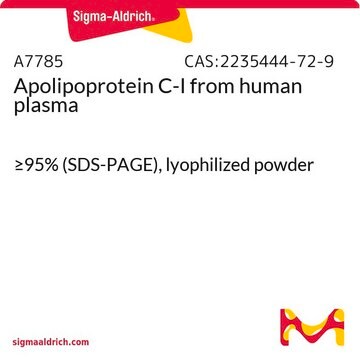A0722
Apolipoprotein A-I from human plasma
≥85% (SDS-PAGE), buffered aqueous solution
Synonym(s):
Apo A-I
Sign Into View Organizational & Contract Pricing
All Photos(1)
About This Item
Recommended Products
biological source
human plasma
Quality Level
Assay
≥85% (SDS-PAGE)
form
buffered aqueous solution
mol wt
28.3 kDa
technique(s)
ELISA: suitable
UniProt accession no.
shipped in
dry ice
storage temp.
−20°C
Gene Information
human ... APOA1(335)
Looking for similar products? Visit Product Comparison Guide
Application
Apolipoprotein A-I from human plasma has been used to induce cholesterol efflux in nitrobenzoxadiazole (NBD)-cholesterol loaded cells. It has also been used to detect IgG anti-apoA-1 antibodies using enzyme linked immunosorbent assay (ELISA).
Major protein components in high density lipoprotein (HDL)
Biochem/physiol Actions
Activates lecithin-cholesterol acyltransferase (LCAT), which is responsible for cholesterol esterification in plasma.
Apo-AI comprises ~70% of the protein moiety in HDL. It is a single polypeptide chain consisting of 245 amino acids with glutamic acid as the C-terminal residue and aspartic acid as the N-terminal residue. The molecular mass is reported to be 28.3 kDa. The protein is made up of one major isoform (pI 5.6) and two minor isoforms (pI 5.53 and 5.46). Apo-AI shows a high content of α-helix structure. The amphipathic regions in the α-helix structure seem to be responsible for lipid binding capacity. In aqueous solution, Apo-AI shows self-association with minor conformation change. Apo-AI activates lecithin-cholesterol (LCAT) acyltransferase, which is responsible for cholesterol esterification in plasma.
Apo-AI levels in normal plasma are 90-130 mg/dl. Apo-AI levels may be inversely related to the risk of coronary disease.
Apo-AI levels in normal plasma are 90-130 mg/dl. Apo-AI levels may be inversely related to the risk of coronary disease.
Physical form
Solution in 10 mM ammonium bicarbonate
Disclaimer
RESEARCH USE ONLY. This product is regulated in France when intended to be used for scientific purposes, including for import and export activities (Article L 1211-1 paragraph 2 of the Public Health Code). The purchaser (i.e. enduser) is required to obtain an import authorization from the France Ministry of Research referred in the Article L1245-5-1 II. of Public Health Code. By ordering this product, you are confirming that you have obtained the proper import authorization.
Storage Class Code
10 - Combustible liquids
WGK
WGK 3
Flash Point(F)
Not applicable
Flash Point(C)
Not applicable
Choose from one of the most recent versions:
Certificates of Analysis (COA)
Lot/Batch Number
Don't see the Right Version?
If you require a particular version, you can look up a specific certificate by the Lot or Batch number.
Already Own This Product?
Find documentation for the products that you have recently purchased in the Document Library.
Customers Also Viewed
Sara Croca et al.
Arthritis research & therapy, 17, 26-26 (2015-04-19)
IgG anti-apolipoprotein A-1 (IgG anti-apoA-1) antibodies are present in patients with systemic lupus erythematosus (SLE) and may link inflammatory disease activity and the increased risk of developing atherosclerosis and cardiovascular disease (CVD) in these patients. We carried out a rigorous
H J Menzel et al.
The Journal of biological chemistry, 259(5), 3070-3076 (1984-03-10)
Variant forms of apolipoprotein A-I (apo-A-I) have been shown to exist in the human population. One mutant form, referred to as apo-A-I-Münster-3, is one charge unit more basic than normal apo-A-I on isoelectric focusing gels. This variant has the same
Adipose-derived exosomes exert proatherogenic effects by regulating macrophage foam cell formation and polarization
Xie Z, et al,
Journal of the American Heart Association, 7(5), e007442-e007442 (2018)
IgG anti-apolipoprotein A-1 antibodies in patients with systemic lupus erythematosus are associated with disease activity and corticosteroid therapy: an observational study
Croca S, et al.
Arthritis Research & Therapy, 17(1), 26-26 (2015)
Gabriele Romano et al.
International journal of cardiology, 271, 233-239 (2018-06-17)
Atherosclerosis is a slowly progressing, chronic multifactorial disease characterized by the accumulation of lipids, inflammatory cells, and fibrous tissue that drives to the formation of asymmetric focal thickenings in the tunica intima of large and mid-sized arteries. Despite the high
Our team of scientists has experience in all areas of research including Life Science, Material Science, Chemical Synthesis, Chromatography, Analytical and many others.
Contact Technical Service